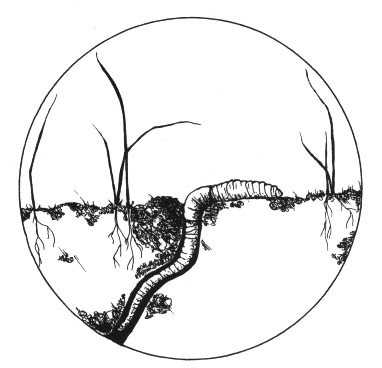
What was it we learned about earthworms?
When we were kids, they were squiggly things that either fascinated or disgusted us. If we fished, they were likely the key to our first angling success. As we made our way into the garden, we came to call them “nature’s little farmers,” tilling and fertilizing in one operation. Charles Darwin described their beneficial effect on soil structure and fertility. Aristotle referred to them as “the intestines of the Earth.”
Forest scientists, however, are now asking that we re-think how beneficial earthworms really are to the natural processes at work in forest soils. They may be doing more harm than good.
The common night crawler we all know (Lumbricus terrestris) is one of many species of earthworms, all members of the phylum Annelida, which also includes worms and leeches. Whatever earthworms were native to North America found themselves scraped into oblivion by the last Ice Age; only remnants of certain species remained in the southeast and on the Pacific coast. Until, that is, European settlers came, bringing European earthworms in soil, plant roots, and livestock hooves.
Fast forward to the 1980s, when forest ecologists noted a decline in the quantity and health of understory shrubs and wildflowers in the northern forests of the United States and in Canada. Research in Minnesota, Wisconsin, and Ontario first focused on the possible presence of toxic minerals like lead and mercury. Testing for these elements came up empty, but scientists noticed that areas most subject to this decline contained more earthworms than in places less affected.
Further study showed that earthworms are most common around forest lakes, ponds, and streams, in part because of anglers’ common practice of depositing unused fishing bait there.
Farmers and gardeners appreciate earthworms in agricultural soils because they digest coarse organic matter and turn it into “castings” that are high in vital plant nutrients and because their tunnels loosen and aerate compacted dirt. This improves drainage; when ample water and nutrients are available, as happens with intensive agriculture, enhanced drainage is beneficial to crop growth.
In the forest, however, the layer of decaying organic matter that carpets the forest floor is essential to nutrient conservation. From top to bottom, this layer ranges from newly fallen leaves and woody material to more decayed matter, called duff. Just like a sponge, this layer retains water and is home to a complex web of microlife that slowly processes nutrients, feeding both the plants and the microlife itself.
Worms introduced into this web act like a garbage disposal. In the presence of large numbers of worms, the duff layer that normally takes several years to decay can be almost fully digested in one summer. The result is a nearly bare, more mineralized soil that becomes foreign ground to many native forest plant species like large-flowered trilliums, yellow violets, and Solomon’s seal. The rare goblin fern, for example, native to some northern hardwood forests, hosts a fungus that assists the fern in extracting soil nutrients. When earthworms graze the fungus, the fern loses a vital advantage and may thus be nudged toward extinction.
The problem is greatest in hardwood forests having neutral to alkaline soils, which earthworms prefer over the more acidic soils typically found beneath softwood.
One damaging result of earthworm activity is that affected soils become more receptive to other invasive species. In southern Vermont and New Hampshire, landowners are noticing that the understory in oak- and maple-dominated forests is becoming overrun with species like buckthorn and barberry. Absent the natural conditions favoring regeneration of native species, these invaders threaten not just natural wildflowers and shrubs but also the birds and other animals that rely on them for food and cover. The invaders threaten the very future of these forests as productive timber resources: buckthorn makes lousy hardwood flooring.
Scientists, often cursed with the task of giving us new things to worry about, don’t foresee any way to remove invading worms from places already colonized. Some do, however, believe that the spread of non-native earthworms could be slowed, especially if more people were aware of the problem. Anglers should not leave worms behind when their creel is full, and people in some areas may need to consider restrictions on worms as bait. In addition, landowners can be attentive to symptoms of the problem and can find sources of native plant seed stock to recolonize affected areas.
Worms don’t migrate quickly; they advance no more than 15-30 feet per year. (That’s part of the reason why the problem is only coming to light now, hundreds of years after the first European earthworms arrived.) Perhaps common sense and care will keep them in the garden, where their virtues can best be appreciated.

